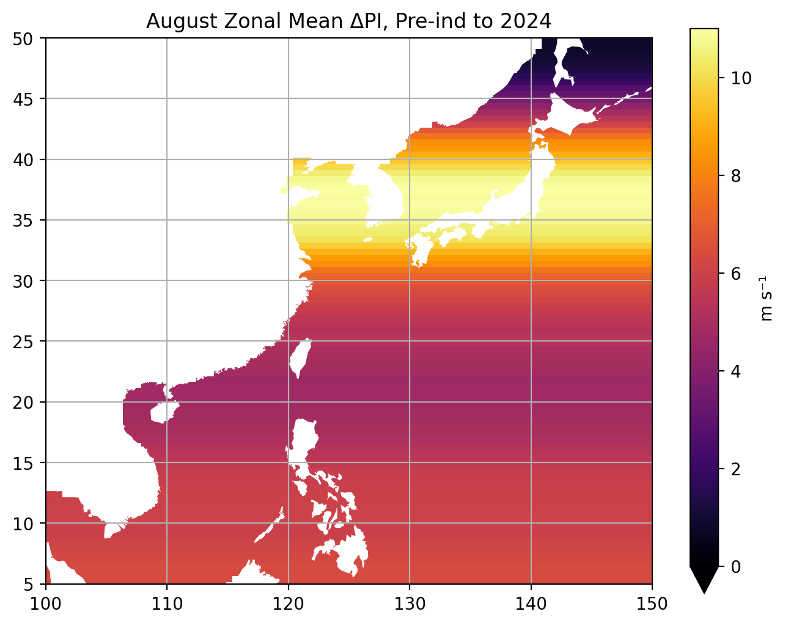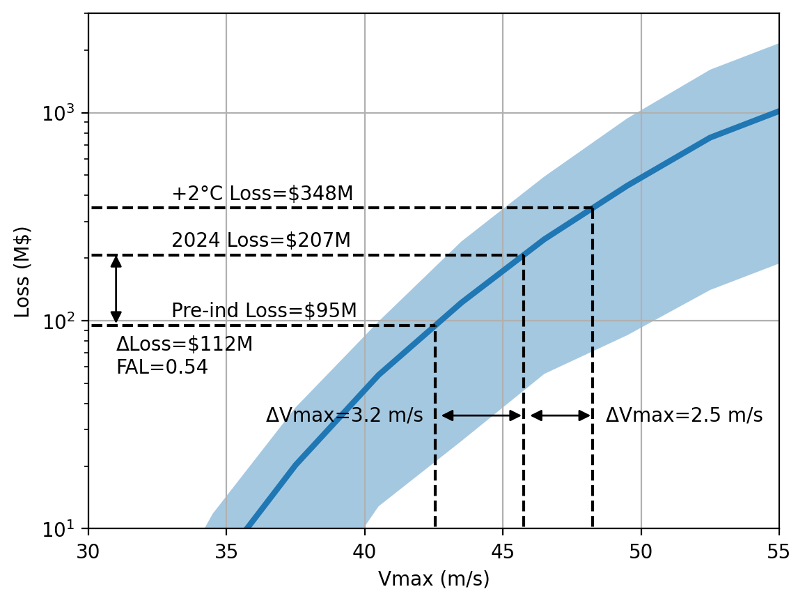Published August 2024.
Summary
The IRIS model estimates that climate change uplifted the intensity of a Typhoon of the type “Shanshan” from a Category 1 to a Category 2 at landfall. A “Shanshan” type typhoon at landfall is about +36% more likely in the 2024 climate compared to a pre-industrial baseline. We also estimate that most, 54%, of the damage in Japan of a “Shanshan” type typhoon can be attributed to climate change compared to the pre-industrial baseline. In a future +2°C warmer world we estimate an additional +68% to the current damages.
Background
Typhoon Shanshan had a life-time minimum pressure of 932 hPa over the Pacific making it a Category 4 typhoon. It was the fourth typhoon of the 2024 Pacific Typhoon season. Shanshan was a Category 2 typhoon at landfall in Kyushu Island on the 29th August.
The IRIS model (Sparks and Toumi, 2024) can be used to infer the additional strengthening of a “Shanshan” type storm that can be attributed to recent warming or more specifically to recent changes in potential intensity. We first need to consider the change in the thermodynamic environment. There has been a recent global warming of about 0.2°C/decade putting the 2024 global mean temperature close to about 1.3°C above pre-industrial temperature. ERA5 reanalysis is used to calculate monthly mean PI fields between 1980 and 2024. We consider global warming to manifest itself differently with latitude. We have low confidence in attributing regional or longitude trends to global or anthropogenic warming. The regional changes are more likely to be caused by decadal variations and less likely to be sustained or representative of global warming.
To calculate the PI field in any given year we apply the corresponding monthly (August) global zonal mean trend to the 1980-2024 monthly mean PI field. In this way we can estimate the regressed anomalous PI field in any month since industrialisation and scale this by the simultaneous global mean surface temperature. This regressed value is not the actual PI now but that portion due to a linear change since 1980. The pre-industrial state is equivalent to the global mean surface temperature of the 1950s. The pre-industrial value of PI is determined by regressing ERA5 backwards in time.

Figure 1. Zonal mean potential intensity, PI, difference for August between now (“2024”) and pre-industrial.
Figure 1 shows the zonal mean difference in August PI between 2024 and the pre-industrial estimate. There are large trends in the tropics which decline towards the subtropics and then increase again at larger latitudes. This meridional structure is interesting and is different to the SST trends which tend to gradually increase from the tropics to higher latitude. The difference in pattern between PI and SST is caused by the important role of moisture trends. The PI difference between 2024 and pre-industrial is about +6 m/s in the Pacific. We can also scale the current PI trends to project the PI changes to a +2°C warmer world. This increases the PI by about a further 3 m/s from today.
The frequency of landfall is the next consideration. The IRIS model does not change the number of events in the Pacific, only the initial life-time maximum intensity is modified by the PI. Figure 2 shows the events of the 10,000 year simulation of typhoons near Japan (within 1 degrees of the actual landfall location). The tracks in IRIS are generated as deviations of the observed/historical “parent tracks”. This method does convert many historic “near misses” to then enter the region of interest.

Figure 2. Simulated and observed event locations in the vicinity (1 degree radius) of Shanshan landfall.
Maximum Wind Speed At Landfall
Figure 3. shows the return period plot for Typhoon wind speeds in the region near Shanshan’s landfall (1 degree radius) as observed and modelled. Landfall observations in the region are sparse over the 45 years used to build the IRIS model. However, the 1 degree radius region gives a reasonable sample for validation. In the case of Shanshan, a Category 2 at landfall, we estimate that this type of event was about 36% more likely compared to pre-industrial times. The return period has decreased from 19 yr to 14 yr. For the same return period the current wind speed compared to pre-industrial events has increased by 3.2 m/s or 7.6%. This is equivalent to making this type of storm more intense from Category 1 to 2. In a +2°C degree warmer world, the landfall wind speed increases by a further +2.5 m/s compared to the current climate (+1.3°C).

Figure 3. Landfall wind speed vs return period for the vicinity (1 degree radius) of Shanshan landfall as calculated for the current climate “2024” (orange line), pre-industrial (blue line). FAR is the Fractional Attributable Risk (Equation 1) of landfall with a maximum wind speed of 46 m/s in the 2024 scenario ΔVmax is the change in Vmax from the pre-industrial scenario.
In the climate change attribution literature the fractional attributable risk, FAR, is frequently used. FAR is here defined as
FAR = (Pnow - PPre-Ind) / Pnow (1)
where Pnow and PPre-Ind are the probabilities of an event of the minimum intensity for the current (now) and pre-industrial (Pre-Ind) climate respectively. The FAR for “Shanshan ” type is 0.27. This means that 27% of the likelihood of this type of event can be attributed to climate change.
Attributing Economic Damage
We are using IRIS to make an estimate of economic damage. We have combined IRIS wind fields with a single damage function (Eberenz et al. 2021) and 10 km gridded exposure adjusted for population growth and inflation (Eberenz et al. 2020). For the damage function we apply a minimum wind threshold for damage of 25.7 m/s and a half-damage wind speed of 135.6 m/s. We create a loss against intensity curve by calculating the damage for many stochastic TCs following the track of Shanshan.. We then apply the landfall wind speeds for pre-industrial conditions, today (+1.3°C) and for a +2 °C world (compared to pre-industrial) to the loss curve to estimate the damages.
Figure 4 shows the economic damages estimated. We find the wind speed increase of this type storm makes substantially more damage. The pre-industrial climate scenario is a counterfactual with the current exposure and vulnerability. To communicate the effect of climate change on loss we propose a new variable: the fractional attributable loss, FAL. It is defined as
FAL = (Lnow-LPre-Ind)/Lnow (2)
where L is the economic loss for the current (now) and pre-industrial climate (Pre-Ind).
We estimate the FAL for “Shanshan ” is 0.54 because of the climate change driven intensification. This means 54% or nearly half the economic damage can be attributed to climate change compared to the pre-industrial baseline. We made many sensitivity studies and concluded that we can be more confident in the estimate of the fractionable attributable loss than the absolute loss estimate. The future additional loss in a +2°C degree warmer world is an additional +68% from the current damages.

Figure 4. Economic damage (2024 M$US) vs maximum wind speed at landfall calculated along the track of Shanshan. Dashed lines show the pre-industrial, current and + 2°C scenario. Change of wind speed is +3.2 m/s from pre-industrial to current and a further +2.5 m/s from current to +2°C. FAL is the fractional attributable loss for the intensification due to climate change to date (Equation 2). Line shows the mean and shading shows the 10%-90% percentile range.
Eberenz, S., Stocker, D., Röösli, T., and Bresch, D. N.: Asset exposure data for global physical risk assessment, Earth Syst. Sci. Data, 12, 817–833, https://doi.org/10.5194/essd-12-817-2020, 2020.
Eberenz, S., Lüthi, S., and Bresch, D. N.: Regional tropical cyclone impact functions for globally consistent risk assessments, Nat. Hazards Earth Syst. Sci., 21, 393–415, https://doi.org/10.5194/nhess-21-393-2021, 2021.
Sparks, N., Toumi, R. The Imperial College Storm Model (IRIS) Dataset. Sci Data 11, 424 .https://doi.org/10.1038/s41597-024-03250-y, 2024